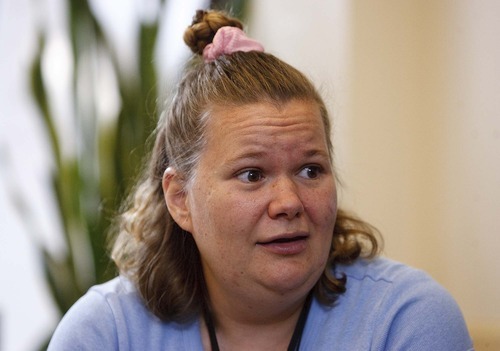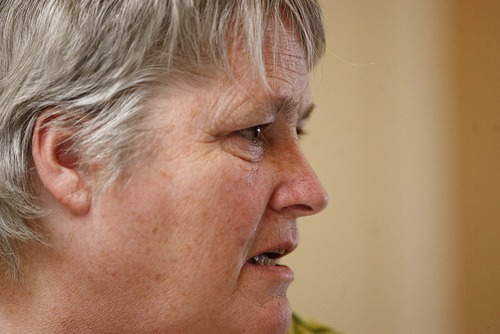This is an archived article that was published on sltrib.com in 2010, and information in the article may be outdated. It is provided only for personal research purposes and may not be reprinted.
In 2009, Valley Mental Health announced it was facing a steep deficit and planned to lay off up to 125 employees.
But for its best-paid employees, it had been a very good year.
Some staff members, with salaries approaching or exceeding $200,000, had seen their income increase by 10 percent and more. Revenue was up by more than $5 million.
And money continued to flow in from businesses and properties the organization has branched into over the decades.
Meanwhile, insisting it feared a looming $8 million to $10 million shortfall, the state's largest mental health provider cut and reorganized programs. Clients wept.
Perhaps the most surprised to learn of Valley's budget quandary was Salt Lake County, which had an annual contract with the organization worth about $55 million, primarily in Medicaid dollars.
"We couldn't see an $8 million cut on the horizon," said Tim Whalen, the county's mental health director. "We had worked out a budget where we felt like they were funded through the year and foreseeable future."
In the more than two decades since it broke away from Salt Lake County government, Valley Mental Health has evolved into what some critics describe as an empire, with generously paid staff and opaque spending practices. The county has called for more transparency for years, challenging some salaries and other financial decisions while raising questions about conflicts of interest and expanding assets.
Still, it routinely allowed Valley to retain unspent Medicaid funds — Valley pocketed $4.8 million in such taxpayer dollars in 2009.
Now the county is taking control.
In a dramatic shift, officials have hired a new company, OptumHealth, to manage their mental health programs beginning next summer. They say they will require more frequent and extensive reports about how Medicaid funding is used. And under the new arrangement they will direct how to spend those dollars — taking that job away from Valley for the first time in more than 20 years.
"We weren't at the table making the decisions — we were hearing what was decided," said Zac Case, the fiscal manager for the county's division of behavioral health. "They may have been great decisions, but now with the change the county will be more in the driver's seat."
Valley Chief Executive Debra Falvo defends the private nonprofit's expansion and use of public dollars.
"Bottom line we are a business, a business with a mission. ... We want to be here for years to come, to serve the folks in need. To do that we must use our public and private dollars wisely," she said. "We must stretch ourselves to be as efficient and effective as possible."
—
Questioning an expanding role • County auditors in 2005 traced Valley's evolution from an arm of county government to a sprawling company that included at least partial ownership in low-income apartment complexes, a South Salt Lake nursing home and buildings leased to a variety of tenants, including a Marie Callender's restaurant.
Related organizations, including its Valley Mental Health Foundation and businesses that offered employment and personality assessment, were among organizations either receiving or sending money to Valley.
Over the years, Valley's foundation has directed hundreds of thousands of dollars to the Carmen B. Pingree Center, its program for autistic children in Salt Lake City.
County auditors noted a transfer of $2.6 million from Valley's foundation back to Valley "[as repayment] for items associated with the building and program at Pingree School."
An accounting firm had found that in three cases, Valley did not use a competitive bidding process for large construction projects, including the Pingree school, according to a 2002 internal county memo. The contractor used for the school was the husband of a foundation board member, the memo said.
The 2005 presentation led Jean Nielsen, director of the county's department of human services, to urge the council to give Valley more direction on "how public money is spent," the April 19 minutes show. That year, Valley received just over $50 million via the county's Medicaid contract to provide mental health care to low-income residents. It kept unused dollars that year, though it lost $2.3 million the next year when it offered more services than it was paid for by contract.
"Valley Mental Health is of the opinion that once federally mandated services have been provided, they can spend public money any way they wish," Nielsen said, according to the minutes.
Dave Brenna, the county's mental health director from 2000 to 2005, recalls the questions that arose during that era.
"Some people thought that Valley Mental Health should probably not grow and that it had grown beyond its mandate," he said.
After the 2005 report, Valley increased its financial reporting to the county, but the change was temporary, according to Jim Wightman, director of the county's internal audit division. And five years later, he says, its spending patterns are still relevant.
"A lot of what are arguably public funds have been used by Valley to engage in activities through their foundation that greatly increased the scope and objective of their organization," Wightman said. "Carmen Pingree [school] is a good example. It's a worthy cause, but it was not within the original scope of the primary mission of county mental health — which is to provide mental health services to the indigent population."
A $3.2 million advance from Valley remains on the foundation's books. "We see the foundation as a place to hold dollars to be used for future services," Falvo said.
But Allan Ainsworth, founder of the homeless health care provider Fourth Street Clinic, questions why Valley hasn't invested more money into programs for the uninsured. "From the perspective of the uninsured they were not meeting the needs of the community," Ainsworth said.
Salt Lake County Councilman Dave Wilde said perhaps the council should consider reviewing Valley's history to learn for the future.
"Buying the properties and using them to generate more revenue to supposedly support the projects they're doing — I just think it certainly made me say: How far do you ride that horse?" he said. "Can they go open a McDonald's restaurant and use profits for that to help our mental health mission?"
—
Defending diversification • Falvo defends Valley's expansion, noting that rents, investments and fundraisers help rebalance its budget. She is adamant that continuing to fund the Pingree Center is an appropriate use of mental health dollars "because with autism, I'm not sure I don't have one kid who doesn't also have another mental health diagnosis."
Dale Newton, Valley's chief financial officer, explains that having money built up within the foundation allows it to match donor dollars and demonstrate its financial health.
Valley's $3.2 million advance to the foundation may include public funds, he said.
The money could be returned "at any time," he said. "But, again, you start to lose the ability to leverage private contributions when you don't have an active, up-and-running foundation."
Falvo points out that Valley spends millions each year — $4.4 million in fiscal 2010 — on charity care, providing help to residents who do not qualify for Medicaid and are uninsured. That care is only possible because Valley raises money through ventures outside its Medicaid contract, she emphasizes. Also, excess Medicaid revenue allows the company to pay for costs that aren't covered by Medicaid, such as helping clients learn how to budget and offer transportation to therapy.
Under its contract and via charity care, Valley cares for more than 20,000 clients a year; even so, it turns some people away.
"You still have to find some way to pay for that person," Falvo said.
In 2009, the county's Medicaid contract equaled more than $55 million; Valley's total revenue was $89 million, tax records show. Its expenses, ranging from salaries to building maintenance, totaled $87.9 million.
Its growth and diversification have not diminished Salt Lake County Councilman Randy Horiuchi's enthusiasm for their business model.
"They're providing millions and millions of dollars of mental health services that they probably wouldn't have provided if they were still an entity of county government," he said.
He reflects that the county's oversight has probably ranged from too much to perhaps occasionally too little.
"That's the nature of government when you have elected officials," he said. "In my view, Valley has undergone a pretty thorough scrubbing."
—
Staying competitive • Valley has about 1,200 employees, from social workers to nurses to case managers to psychiatrists. Each year in 2008, 2009 and 2010, at least 23 staffers were earning more than $100,000, annual reports to Salt Lake County show.
More than half of those top earners were being paid more than $150,000 as of the beginning of this year. Some of the best-paid staff are psychiatrists whose profession requires high pay, Falvo said.
"We have struggled to stay competitive in terms of trying to keep doctors," she said. "Lots of our colleagues pay our doctors a lot more than we do."
In 2007, Valley's former CEO, Dave Dangerfield, was paid $167,690 although Falvo had stepped into the job. Though he had left the organization, Dangerfield had one year left on his contract, so he continued to collect his salary while Falvo earned $160,655 in her new position, county records show. Dangerfield could not be reached for comment.
Some of the largest compensation jumps in the past few years were due to a recent Valley policy allowing employees to cash out accrued vacation pay.
"That's a good thing for the company," said CFO Newton, explaining the company can pay the employee at the current pay rate rather than a future rate.
Other increases stem from a market adjustment to doctors' hourly rates, using salary comparisons. Some doctors were paid more because they spent more hours with clients.
And all employees received a 2 percent bump in November 2009 — roughly the same time period that Valley was announcing cuts.
—
Valley's future • The widespread layoffs Valley predicted in 2009 didn't happen. Instead, 13 employees retired, and 50 positions were eliminated while 35 new positions were created.
In the reorganization, Valley moved toward more group-based care. It has fewer licensed professional counselors and offers more group sessions with therapists, along with seeking more involvement by friends and family of the mentally ill.
"Everybody likes to talk a lot about the money side, but the driving source was to do a better clinical model," Newton said.
Still, there is a financial benefit, Falvo said.
"The hope is as you move to more groups, that you do move to a less expensive model so you can serve more people," she said.
Newton said it's likely Valley will end this year with a loss, although "I think it won't be as much a decline as we thought it would be," he said. Officials had worried a decrease in stimulus dollars and a changing Medicaid rate were among the reasons the deficit would occur.
OptumHealth is poised to take over the county's management contract for mental health services in July. Valley leaders hope to continue to care for Medicaid patients in Salt Lake County under Optum's oversight.
It is not clear how much the new arrangement will reduce the Medicaid dollars it receives.
"We do know we want to continue to be a premier provider of care," Falvo said.
Salaries grow at Valley
Between 2008 and 2009 some of Valley's top earners saw their compensation go up by 10 percent or more. › A6















